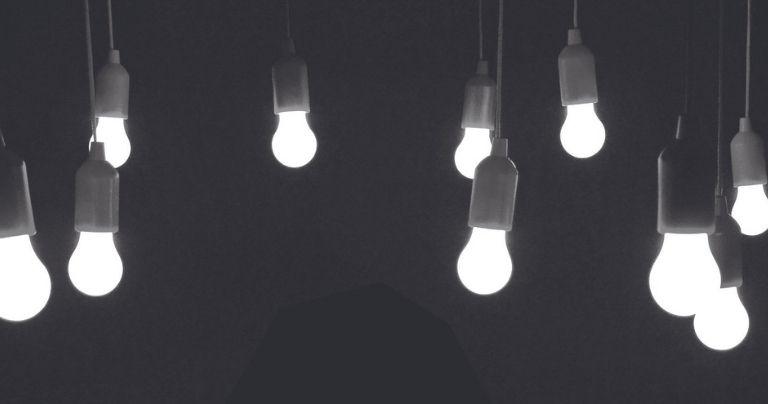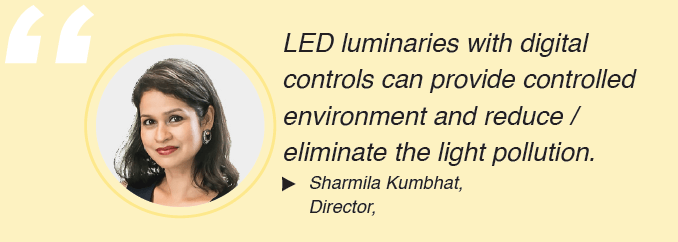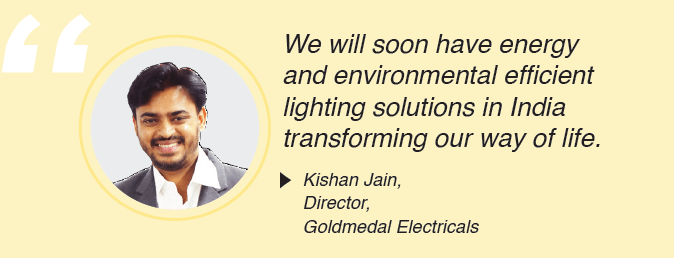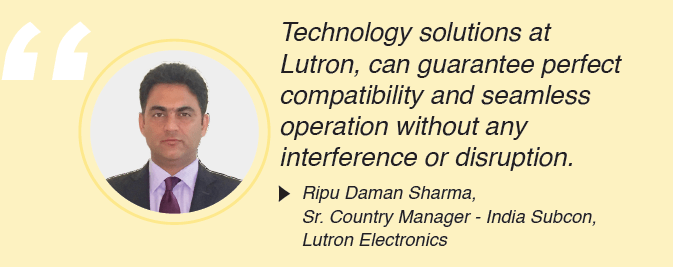LED Luminaries with digital and sustainable controls hold the future
By EPR Magazine Editorial December 23, 2021 1:49 pm
By EPR Magazine Editorial December 23, 2021 1:49 pm

Lighting industry experts share their optimism on creating a sustainable world by implementing advanced technologies in lighting.
Smart and efficient lighting systems in a smart city
Globally, lighting as an industry is growing at an alarming pace with a projected value of around US$2000 Million. This decade is going to witness phenomenal changes, as the last decade thrust was energy saving measures, which gave rise to the LED-lighting to replace all other conventional lighting. Application of solid state devices as a source of lighting has given way to new concepts in lighting control and automation.
Sharmila Kumbhat , Director, K-Lite Industries, says “With the government’s plan to have 100 smart cities in India, the demand for smart and efficient lighting in commercial and residential segment is going to be a major challenge. The availability of automated changes with the digitally addressable dimming interface, drivers with CCT tuning capability and many other devices, will drive the consumers in smart cities to demand for automated changes in lighting levels to affect mood, emphasise architecture, illuminate art, and influence action.”
Kishan Jain, Director, Goldmedal Electricals, says “With the increasing awareness on energy conservation and smart technologies, there has been a steady rise in the demand for smart devices. Owing to their quality of being energy efficient, the government of India has installed LEDs in many public spaces. LEDs have been gaining tremendous popularity for both commercial and residential use across the country. With easy availability and access to the internet and smart devices, we expect a major boom in the upcoming years.
Ripu Daman Sharma, Sr. Country Manager – India Subcon, Lutron Electronics, says “For smart homes, there is a huge demand considering it’s where people spend most of their time in their entire life. Everyone wants their home/office/commercial premises to be convenient and efficient to facilitate their daily routine. In most cases, it’s the employers who want to turn their workplaces into smart ones in order to increase productivity and yield additional revenue.
Electrical trends impacting the energy-efficient lighting systems
The phenomenal growth in electricity demand coupled with depletion of natural resources for electricity generation and the compelling necessity to reduce carbon emission etc., drove the whole world to find measures to save energy in whatever way one can think of. Noting the impacts, Sharimla feel that this situation gave rise to electricity generation using renewable and non conventional energy sources and measures to find and implement energy efficiency in all areas and take strict measures to prevent wastages in energy usage. The concept of smart lighting is one such measure for energy saving and has to stay through smart city concepts and smart lighting applications.
Whereas, Kishan notes that pandemic has widely reshaped our way of living. Many have been restricted at home and their electrical needs have doubled, leading to a massive surge in their electricity bills. We are witnessing a shift in electrical trends with an increased demand for smart and energy-efficient solutions. Consumers are looking for energy-efficient, long-lasting and preferably smart LEDs that also look stylish. This will allow them to limit their energy consumption and lower their carbon footprint without compromising on the décor aesthetics of their space.
According to Ripu, “Automation initially did not find much traction among consumers, due to the heavy set up costs involved. However, with time we are seeing customers becoming more responsive to smart technology and giving way to wireless systems extending to smart buildings.” The intent is to create intelligent applications, wherein, they optimally perform functions based on user behavior, optimal usage and so on. We see there will be increasing demand for wireless solutions which can save substantial cabling and labor time and cost. As a result, we will see more and more existing buildings and homes adopting lighting controls.

Role of IT, IoT and IIoT in enabling energy efficient lighting
Smart cities use Internet of Things (IoT) devices such as sensors, lights, and meters to collect and analyse data. The cities then use this data to improve infrastructure, public utilities and services, and more. “Transformation of all cities (Tier 1 and Tier 2 to start with) has potentially increased orders to the manufacturers and in particular the lighting business. Demand is expected to grow fast in the years to come,” says Sharmila.Kishan, on the other side is of view that, we are still at the very nascent stage in this segment. Huge developments are happening around the world and with the world becoming smaller in every way; it is just a matter of time before we in India see these innovations in different forms in our life. Homegrown electrical companies such as Goldmedal are betting big on the IoT technology and home automation segment as it doesn’t just impact lighting but also various other electrical products.
As per views by Ripu, “In response to an emerging trend in building design, tunable white control strategies are being integrated into lighting systems which allow to adjust color temperature and intensity to best suit the occupants in the space.” User-friendly interface systems allow building managers to be more proactive, increase operational efficiencies and reduce costs.
Many technologies offer an ideal mix of energy-saving lighting control strategies that reduces glare and heat gain, load shed and more. These systems help to meet energy and sustainability goals and provide the tool to easily monitor and adjust system performance over time. “Most of important of all, Lutron offers all these technologies under one roof which can guarantee perfect compatibility and seamless operation without any interference or disruption,” Ripu adds.

Lighting technologies contributing to CO2 emission
“It is only after energy crisis/global warming due to various factors including environmental degradation etc., and the absolute need for energy saving measures were tightened, the possibility of substituting LEDs as a light source in the place of conventional sources like mercury vapour/SV/MH/FTL/CFL lamps etc., was thought of,” Sharmila explains. Ecological balance ensures the stability of the organisms and environment. How the excessive uncontrolled artificial lighting known as light pollution contributes to the ecological imbalance is being highlighted everywhere.
Light pollution is excessive, misdirected, or obtrusive artificial (usually outdoor) light. The main causes of light pollution are poor planning, excessive use of light, street lamps, light from houses and garage lamps, and night time-lighting. It is in such a context that LED luminaries with digital controls have all the provisions for a controlled environment and reduce/eliminate the light pollution.
Kishan is also of same view, he says “Lower energy consumption has a direct correlation to the amount of CO2 emitted in the atmosphere. As we continue to innovate, the energy consumption of all electrical products with lighting devices is bound to decrease further leading to even more reductions in emissions.” Alongside, the push for sustainable and green energy can tilt the scales in our fight to contain Co2 emissions on this planet.

Moving towards a sustainable future
Sustainability and safety are not mutually exclusive. Sustainability is about reuse, renew and recycle and how to use less to avoid depleting the resources on earth. A lot of the measures and technologies actually involve using fewer resources to achieve the same or even better results, like wireless lighting control and shading systems, personalized control of daylight for best lighting environment and wellness, the use of automated shades to maximize natural light and views, and the new technology to mimic daylight to increase comfort and productivity. “Companies must be willing to change and accept new technologies to balance sustainability with safety for the well-being of their staff and the earth as a whole” Ripu concludes.
We use cookies to personalize your experience. By continuing to visit this website you agree to our Terms & Conditions, Privacy Policy and Cookie Policy.